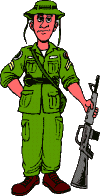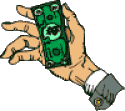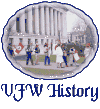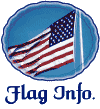![]()

 Unlike many countries, the United States has no "military class". Its
armed forces are made up of civilians who choose - or are chosen- to join one of the
services, and who can elect to serve for a short period of time or a lifetime career. Once
a serviceman's membership in the armed forces ends, he automatically returns to his former
status as a civilian. Unless he is rich, his life will be affected by the same economic
winds that affect the lives of other citizens. Hard times will be equally hard for him,
and may even be harder if he sustained injuries or health problems while in the military. Unlike many countries, the United States has no "military class". Its
armed forces are made up of civilians who choose - or are chosen- to join one of the
services, and who can elect to serve for a short period of time or a lifetime career. Once
a serviceman's membership in the armed forces ends, he automatically returns to his former
status as a civilian. Unless he is rich, his life will be affected by the same economic
winds that affect the lives of other citizens. Hard times will be equally hard for him,
and may even be harder if he sustained injuries or health problems while in the military.Toward the end of 1929, the economic winds that had previously swept veterans and non-veterans alike into an era of unparalleled prosperity shifted their direction cruelly. Beginning in late October 1929, almost every citizen in the country had felt the deadly effects of the depression precipitated ;by the crash of the stock market.
In 19321, the VFW's bonus campaign suddenly took on a new urgency. Early that summer, Congress passed Public Law 212, a measure that would slash veterans' entitlements to the bone. It now appeared that unless payment of the cash bonus was authorized, most veterans would receive no government assistance whatsoever for the duration of the depression. One factor that complicated and prolonged the campaign for the cash bonus was the lack of cohesion among the three major veteran's organizations: the VFW, the American Legion, and the Disabled American Veterans (DAV). Whether because of disagreements as to which organization should lead the campaign or differences in opinion about what veterans were entitled to, the three groups found it nearly impossible to agree on a course of action. Finally, in 1935, the DAV and the American legion both joined the VFW in an all-out effort to push for the passage of Congressman Wright Patman's version of the bonus bill. That year, the Patman Bill passed both houses of Congress, but was vetoed by President Roosevelt. Subsequently, the Senate failed by nine votes to override the veto. The following session, Congress was presented with a slightly different version of the bonus bill: the Patman-Vinson-McCormack Bill. On January 27, 1936, the Senate passed the Patman-Vinson-McCormack Bill over a presidential veto. Under the new law, nearly three and a half million veterans were eligible for almost two billion dollars worth of Adjusted Service Bonds. These bonds, which were immediately redeemable, were available to World War I veterans who qualified by August 1936. On January 28th and 29th, thousands of veterans were lined up outside VFW posts to obtain and fill out the applications. Delivery of most of the bonds was completed by August 1st that year. Although the cash bonus and the nullification of the Economy Act are remembered as two of the VFW's greatest victories, it fought other legislative battles during that same period. For example, the VFW successfully sponsored the Disability Allowance of 1930. In 1940, their efforts were rewarded when Congress passed Public Law 868, which granted $20 million for the construction of veterans' hospitals. Although the VFW's main priority during this period was, as always, to assist veterans and their families, the organization also threw itself into community service. Throughout the depression, posts all over the United States initiated programs to help the needy. VFW members collected and distributed food and served free meals at Post Homes..
In 1935, the VFW again went on record as backing peace for the United States. This time it proposed a four-point program that asked the government to: adopt a permanent neutrality, take federal control of the manufacture and sale of arms and ammunition, conscript wealth and industry as well as manpower in the time of war, and maintain an adequate defense force. To enlist public support for staying out of war, in 1937 the VFW unveiled its "Peace for America" program. Through posters, windshield decals, newspaper publicity, public forums, and radio speeches, all posts helped popularize the VFW's position. As part of the program, in late November the VFW launched a campaign to "Keep America Out of War". Even as the VFW deliberated as to how to preserve peace in America, events that would make neutrality untenable were rapidly unfolding in Europe. On September 1, 1939, Adolf Hitler unleashed his armies and air forces on Poland. Two days later, Great Britain and France declared war on Germany. Shortly afterwards, Russia entered the fray on Hitler's side, helping to crush Poland from the east. By mid-summer 1940, most of Scandinavia, Holland, Belgium, and France had succumbed to Hitler's "blitzkrieg" (combined air/tank/infantry) tactics. With Great Britain standing alone against the rampaging Germans, the U.S. quickly softened its stand on neutrality. Congress voted vast sums for rearmament, and nearly a million men were drafted into military service. Both candidates for president - two term incumbent F.D.R. and Republican challenger Wendell Wilkie - forcefully advocated helping the British in any possible. And when the VFW's National Council of Administration met in Chicago in September 1940, they too strongly endorsed an "Aid to Britain" policy. |
 In
the early years of the depression, the VFW's overriding concern was to obtain some quick
financial relief for the nation's veterans. The VFW fixed on payment of a cash bonus for
wartime service as the surest means to this end. In 1924, the government had granted World
War I veterans "bonus" certificates that would be redeemable for cash in twenty
years. At the time, the VFW had argued that it was senseless to promise a starving man
that he would get money for food two decades later. Now the VFW stepped up its efforts to
persuade the government to redeem the certificates early.
In
the early years of the depression, the VFW's overriding concern was to obtain some quick
financial relief for the nation's veterans. The VFW fixed on payment of a cash bonus for
wartime service as the surest means to this end. In 1924, the government had granted World
War I veterans "bonus" certificates that would be redeemable for cash in twenty
years. At the time, the VFW had argued that it was senseless to promise a starving man
that he would get money for food two decades later. Now the VFW stepped up its efforts to
persuade the government to redeem the certificates early. As part
of its community service, the VFW also started several youth programs. In 1937, borrowing
a concept developed by the Department of Minnesota, it introduced a nationwide program to
teach bicycle safety. This program was operated with the cooperation of local and state
police. About the same time, the organization also received the exclusive right, from the
Amateur Softball Association of America, to sponsor Junior Softball Tournaments throughout
the country. In addition, the VFW established two programs for the children on its members
- the Sons of the VFW, authorized by the 1934 National Encampment, and the Daughters of
the VFW, authorized the following year.
As part
of its community service, the VFW also started several youth programs. In 1937, borrowing
a concept developed by the Department of Minnesota, it introduced a nationwide program to
teach bicycle safety. This program was operated with the cooperation of local and state
police. About the same time, the organization also received the exclusive right, from the
Amateur Softball Association of America, to sponsor Junior Softball Tournaments throughout
the country. In addition, the VFW established two programs for the children on its members
- the Sons of the VFW, authorized by the 1934 National Encampment, and the Daughters of
the VFW, authorized the following year.








 E-Mail
E-Mail